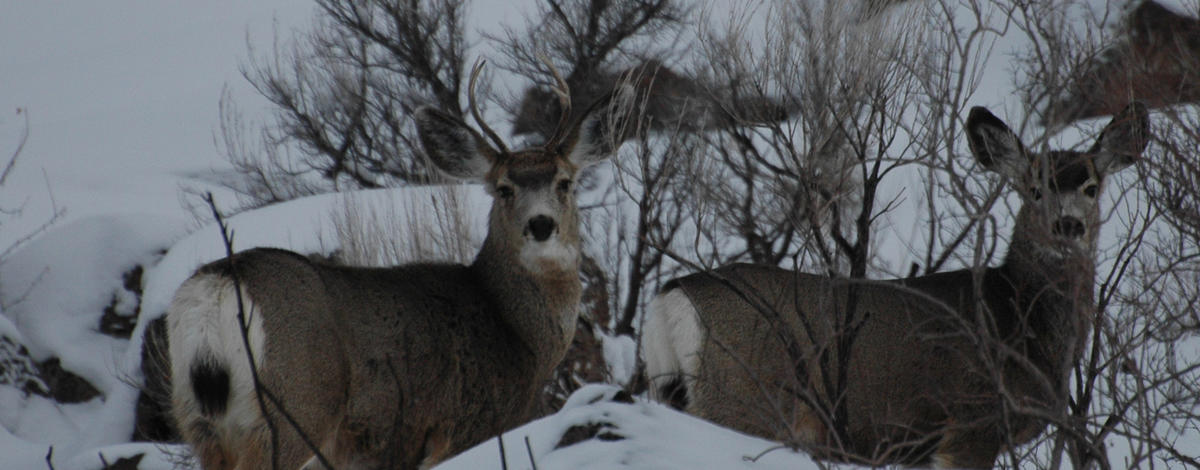As the winter months pass and spring approaches, many people suffering from cabin fever head to Idaho's hills in search of the antlers big game animals have dropped.
Antler hunting, more commonly known as shed hunting, is a fun activity and a reason to get back in the hills. All a person needs is sharp eye and a willingness to endure the ever-changing weather of Idaho.
But it's important to remember that while we're having an early case of spring fever, animals are still trying to get through winter. Although this winter has been relatively mild and adult survival will likely be high, young animals, especially fawns, might still be struggling to get through their first winter.
"Wintering big game animals are very susceptible to any kind of disturbance whether it is from passing motorists, domestic dogs or shed hunters in late winter and early spring," said Daryl Meints, Fish and Game's deer and elk coordinator. "There's growing concern over shed hunters putting additional stress on wintering big game in many areas of the state."
Deer and elk typically rely on their fat reserves to survive winter, and what little nutrients they can gain - if any - from dried vegetation before spring green up occurs and their bodies transition to that fresh, nutritious feed.
Any extra movement an animal makes costs it energy and depletes those fat reserves, which can lead to sickness and oftentimes death, especially for fawns and calves.
"Some animals may be pushed over the edge unintentionally by the very people who want to see them during the fall hunting seasons," Meints said.
Shed hunters can alleviate potential negative impacts by following these simple steps while still enjoying the activity:
Don't disturb big game animals: Human presence alone is enough to cause animals to move and act differently than they would have without that disturbance. A single instance of human disturbance alone may not be that disruptive to animals already stressed by winter, but consider several days of human activity and disturbance. The energy used by animals reacting to repeated disturbances becomes significant.
Respect private lands and follow all road and area restrictions: Like all outdoor recreationists, antler hunters must secure landowner permission to cross or look for antlers on private land. In addition, they must abide by all travel restrictions on federal and state public lands. Keep in mind that some public lands are closed temporarily to human activity during the winter months and early spring to provide security areas free of disturbance. In eastern Idaho, these areas include lands along the South Fork of the Snake River, and areas within the Tex Creek Wildlife Management Area (WMA), St. Anthony desert, and Swan and Teton valleys.
Other public lands are closed to the use of motorized vehicles, but are not closed to human entry. The Boise River WMA in southwest Idaho is closed to all motorized access and dogs must be on a leash. In southeast Idaho, the Soda Hills and 90 Percent Range are also examples of areas where motorized vehicle use is restricted on BLM-managed public land but are not closed to human access by foot or horse.
Remember that following these laws is not some arbitrary guideline: They are there to protect wildlife and the land, and obeying them will make a difference in long-term health of the herds. Before heading out, consult land management travel maps to determine if travel is legal in the area you wish to go to. Second, consider the effect your travel may have on wintering wildlife and if it will cause unnecessary stress. For questions about travel management plans or areas protected from human entry, contact your local U.S. Forest Service, Bureau of Land Management, or Fish and Game regional office.
Park and walk: Do not take motorized vehicles off designated roads and trails - travel by foot or horseback instead. Not only is off-road travel illegal in most areas, but substantial fines are issued to those that don't follow the laws. In addition, even if motorized access is allowed on designated roads and trails, shed hunters should also seriously consider the potential impact to wildlife and damage they may cause to saturated soils. Keep in mind that just because you can drive somewhere doesn't mean you should.
Keep dogs under your control: Though your dog may not chase deer, its presence alone may be enough to cause animals to expend unnecessary energy they would not have otherwise used. To deer and elk, a dog is a predator and the impacts of free-running dogs on wintering game can be substantial. Remember, it is illegal to allow dogs to chase or harass deer and elk.
Watch from a distance: Modern optics provides the ability to watch wildlife from great distances. Use them and you will be much more likely to pick up sheds later and the animal will be better off.
Other reminders: Antler hunters can only lawfully possess antlers that are shed naturally from big game, from animals that have died of natural causes or from a road kill as long as the person completes the self-issued Salvage Permit. The horns of bighorn sheep that have died of natural causes may be recovered but may not be sold, bartered or transferred to another person without a permit from Fish and Game. Bighorn sheep horns must be permanently marked with a metal pin at an Idaho Fish and Game regional office within 30 days of recovery.
Keeping these points in mind when shed hunting will ensure that undue stresses on animals will be avoided or minimized. Some thought and consideration ahead of time can greatly minimize your impact on local wintering wildlife herds and increase your enjoyment in the field.

